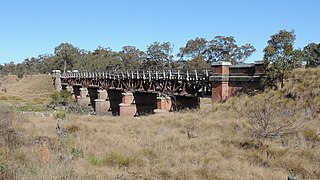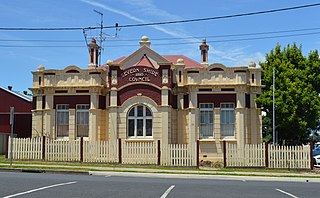
Glen Innes is a parish and town on the Northern Tablelands, in the New England region of New South Wales, Australia. It is the centre of the Glen Innes Severn Shire Council. The town is located at the intersection of the New England Highway and the Gwydir Highway. At the 2016 census, Glen Innes had a population of 6,155.
The Bigambul people are an Aboriginal Australian people of the Northern Tablelands and Border Rivers regions of New South Wales and Queensland.
Yugambal, or Yugumbil (Jukambil), is an Australian Aboriginal language of northern New South Wales.

Stonehenge is a rural locality on the Northern Tablelands of New England in New South Wales, Australia.

Glen Innes Severn is a local government area in the New England region of New South Wales, Australia. The council serves an area of 5,487 square kilometres (2,119 sq mi) and is located adjacent to the New England Highway. The council was formed by the amalgamation of Severn Shire and Glen Innes City Council.
The Gidabal, also known as Kitabal and Githabul, are an indigenous Australian tribe of southern Queensland, who inhabited an area in south-east Queensland and north-east New South Wales, now within the Southern Downs, Tenterfield and Kyogle Local Government regions.

Emmaville is a town on the Northern Tablelands in the New England region of New South Wales, Australia. It is in the Glen Innes Severn Council district.

Bolivia is a locality on the Northern Tablelands in the New England region of New South Wales, Australia. The remains of the settlement comprises the former Bolivia Hotel, a disused post office, a disused railway siding and a community hall.

Deepwater is a parish and small town 40 kilometres north of Glen Innes on the Northern Tablelands, New South Wales, Australia. At the 2021 census, Deepwater had a population of 456.
Marbal (Marbul) is a dialect of the Yugambal language that was spoken around Tenterfield in northern New England, Australia.
The Jukambal were an indigenous Australian people located in northern New South Wales, Australia.
The Geynyon, also written Keinjan, are an indigenous Australian people of southern Queensland. According to research done by Queensland South Native Title Services (QSNTS) entitled South East Regional Research Project (SERRP) 'Geynyan' are in all likelihood an dialect/estate group of the wider Githabul peoples. In May 2021 the Githabul peoples lodged a Native Title claim over much of the former Warwick Shire within the Southern Downs Regional Council area.
The Banbai are an Indigenous Australian people of New South Wales.
The Kwiambal are an Aboriginal Australian people of New South Wales.
The Kambuwal were an indigenous Australian people of the state of Queensland.
The Weraerai (Wirraayaraay) were an indigenous Australian people of the state of New South Wales. They are to be distinguished from the Ualarai.

The Tenterfield Creek railway bridge is a heritage-listed former railway bridge that carried the Main North Line across the Tenterfield Creek from Sunnyside to Jennings, both in the Tenterfield Shire local government area of New South Wales, Australia. It was designed by John Whitton and Engineer-in-Chief for NSW Government Railways and built in 1888. The bridge is also known as the Sunnyside rail bridge over Tenterfield Creek. The property is owned by Transport Asset Holding Entity, an agency of the Government of New South Wales and was added to the New South Wales State Heritage Register on 2 April 1999.

The Yarraford Rail Bridge is a heritage-listed closed railway bridge that carried the Main Northern Line across Beardy Waters, situated 694.371 kilometres (431.462 mi) from Central station, near Glen Innes, in the Glen Innes Severn local government area of New South Wales, Australia. The bridge was designed by John Whitton in his capacity as Engineer-in-Chief for Railways and built in 1886. It is also known as Beardy River Railway Viaduct. The property is owned by Transport Asset Holding Entity, an agency of the Government of New South Wales. It was added to the New South Wales State Heritage Register on 2 April 1999.

Glen Innes Showground is a heritage-listed showground at Bourke Street, Glen Innes, Glen Innes Severn, New South Wales, Australia. It was designed by various architects, including Thompson and Holmes, J. P. O'Connor, Rowland Bros and Madigan and Cusick. It was built from 1873 by various builders, including A. W. Lane, G. Cooper and H. A. Tutt and Son. It was added to the New South Wales State Heritage Register on 4 September 2015.

Severn Shire was a local government area in the New England region of New South Wales, Australia.